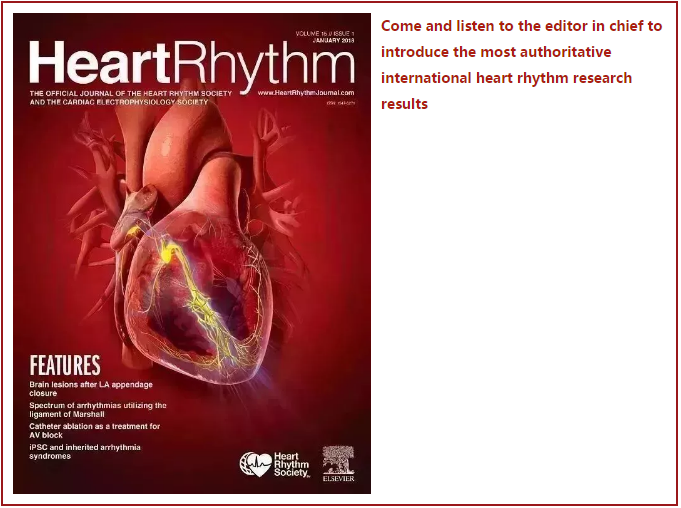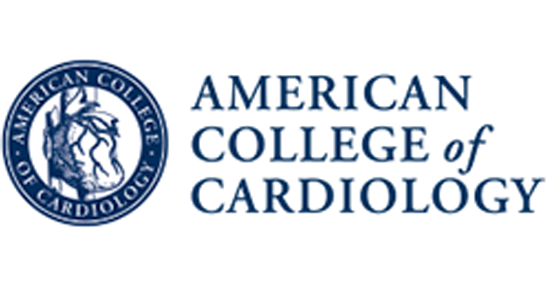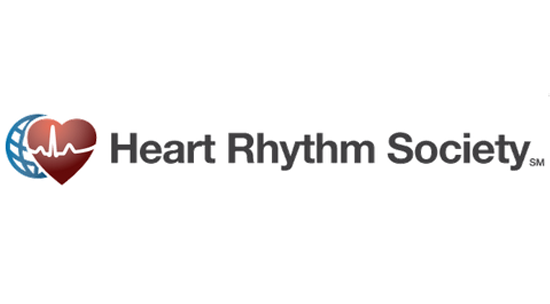HeartRhythm主编—陈鹏生教授语音速递(六月刊 英文版)


1
The first paper is by Jason Andrade et al. The title is “Prevalence and clinical impact of spontaneous and adenosine-induced pulmonary vein reconduction in the Contact-Force vs. Cryoballoon Atrial Fibrillation Ablation (CIRCA-DOSE) Study”. The authors sought to determine the prevalence and clinical impact of spontaneous and adenosine-provoked reconnection using contemporary AF ablation technologies in 346 patients. They found that Patients without spontaneous or adenosine provoked reconnection had better outcomes compared to those with acute PV reconnection. These findings suggest that efforts should be directed towards ensuring an ideal ablation lesion at the first attempt in order to achieve durable pulmonary vein isolation.
2
The next paper is titled “An ECG Sign of Idiopathic Ventricular Tachycardia Ablatable From the Distal Great Cardiac Vein”, written by Lin Yuan-Nan et al. The authors identified 32 patients with idiopathic ventricular arrhythmias (IVA) originating from the DGCV from a consecutive group of 874 patients undergoing IVAs ablation. Among them, 13 had distinct ECG characteristics with notches in the upstroke and downstroke of the R wave in lead III. That sign has a positive predictive value of 92.9% to predict the ventricular arrhythmias arising from the Distal Great Cardiac Vein. The notches in the upstroke and downstroke of the R wave in lead III can help differentiate VT from the adjacent LV endocardium.
3
Coming up next is “Percutaneous Left Atrial Appendage Closure in Patients With Prior Intracranial Bleeding and Thromboembolism” written by Jussi-Pekka Pouru et al. The authors studied 104 patients with atrial fibrillation and prior intracranial bleeding underwent successful LA Appendage Closure. The authors found that there was 69% relative risk reduction of thromboembolism with respect to predicted risk based on median CHA2DS2-VASc score. The authors conclude that percutaneous LA appendage closure with minimized antithrombotic treatment is a valid treatment option in high-risk patients with prior intracranial bleeding and thromboembolism.
4
Next up is a paper tiled “Effect of Acute Myocardial Ischemia on Inferolateral Early Repolarization” by Michael Stoller et al. The authors retrospectively analyzed procedural ECGs of patients with early repolarization undergoing a controlled, 1-minute coronary occlusion for collateral function testing. ECG leads with ER were analyzed before, at 60 seconds of coronary balloon occlusion and >30 seconds after balloon deflation. They found 77 patients with early repolarization patterns in the pre-procedural ECG. During acute ischemia, J-wave amplitude increased in leads showing an ST- segment elevation and decreased in leads with ST-segment depression. Therefore, J- wave amplitude is augmented in leads facing the ischemic territory. This may explain increased arrhythmic vulnerability of patients with early repolarization during myocardial ischemia.
5
Young Min Park et al wrote the next article titled “Short stature is associated with incident sudden cardiac death in a large Asian cohort”. This is a retrospective cohort study of 410,000 Koreans from the Korean National Health Insurance Services National Sample Cohort. During an 8.45-year follow-up period, short stature was identified as one of the risk factors for sudden cardiac death. Each 10-cm increase in height was associated with a 14% decreased risk for sudden cardiac death. These findings supports previously published findings correlating height to sudden cardiac death risk in non-Asian populations. Further studies are needed to understand the underlying mechanisms of this observation.
6
The next paper is titled “Clinical and Functional Reappraisal of Alleged Type 5 Long QT Syndrome-Causative Genetic Variants in the KCNE1-Encoded minK β- Subunit” by Ramin Garmany et al. Retrospective analysis of 1,026 LQTS patients identified six rare KCNE1 variants in 38/1,026 (3.7%) LQTS patients. Collectively, the phenotype observed 22 individuals was relatively weak, with 91% of them asymptomatic. The average QTc was 444 ms. KCNE1-LQTS, or LQT5 likely represents a mild, and potentially more common, form of weakly penetrant congenital LQTS that rarely causes potentially lethal ventricular arrhythmias in the absence of additional genetic and/or acquired risk factors.
7
Coming up next is a paper by Fernando Dominguez et al, titled “Clinical characteristics and determinants of phenotype in TMEM43 Arrhythmogenic right ventricular cardiomyopathy type 5”. ARVC type V is the most aggressive heterozygous form of ARVC predominantly caused by a fully penetrant mutation in the non-desmosomal gene TMEM43, which is endemic to Newfoundland, Canada. The authors studied a Spanish family with p.S358L ARVC-5 without the Newfoundland genetic background. They found that ARVC-5 is associated with high risk of sudden cardiac death and characteristic clinical and ECG features irrespective of geographical origin and genetic background. In these patients as in desmosomal ARVC, vigorous physical activity could aggravate the phenotype of TMEM43 mutation carriers.
8
Duchateau et al wrote the next article titled “Ventricular-triggered atrial pacing: A new maneuver for slow-fast atrioventricular nodal reentrant tachycardia.” In this paper, the authors proposed a novel maneuver to study conduction over the AV node and attempt to induce slow-fast AVNRT. This new method is ventricular-triggered atrial pacing, or VTAP with decremental VA delay. They found that VTAP resulted in a hysteretic conduction curve in 21 of 36 patients in the AVNRT group but only 4 of 21 patients in the control group. A hysteretic conduction curve demonstrates sustained conduction over a slow pathway and concealed retrograde conduction through the fast pathway, a finding in favor of slow-fast AVNRT with a sensitivity of 58% and a specificity of 81%.
9
The next paper is “The Presence of Ectopic Atrial Rhythm Predicts Adverse Cardiovascular Outcomes in a Large Hospital-based Population” by Sung-Hao Huang et al. This is a retrospective study comparing 3000 hospitalized patients with ectopic atrial rhythms and 15000 propensity match patients with only sinus rhythm (SR). Compared with the matched patients, those with ectopic atrial rhythms had higher risk of cardiovascular mortality and permanent pacemaker implantation. These increased risks were associated with the autonomic imbalance measured with heart rate variability parameters. The mechanisms of these associations remain unexplained.
10
Coming up next is a paper by Taylor Cunningham et al, titled “Initially Unexplained Cardiac Arrest in Children and Adolescents: A National Experience from the Canadian Pediatric Heart Rhythm Network”. The authors report a retrospective case series of 46 children presenting with unexplained cardiac arrest. Median age was 13.8 years. The presumed etiology was mainly long QT syndrome or catecholaminergic polymorphic ventricular tachycardia, but no cause was identified in nearly 50% of the patients despite extensive investigations, including cascade genetic screening. Furthermore, 75% of ICD shocks occurred in patients without a diagnosis.
11
Stephanie F Chandler et al wrote the next paper, titled “Adverse Event Rate during Inpatient Sotalol Initiation for the Management of Supraventricular and Ventricular Tachycardia in the Pediatric and Young Adult Population”. The authors studied a retrospective cohort 190 pediatric patients initiated on oral sotalol for SVT or VT. Among them, 110 patients (58%) was < 6 months old. The median pre-sotalol QTc was 438 ms, with range between 348 and 530msec). Three patients had bradycardia and 2 had QTc prolongation (n=2). All 5 patients with adverse events had repaired CHD. The authors conclude that the incidence of adverse events in pediatric patients initiating sotalol for AT, SVT or VT is low (3%) with no deaths or malignant rhythms reported in this series. These data provide some support for a selective strategy of outpatient initiation of sotalol.
12
The next article is by Jeremy Moore et al, titled “Permanent Conduction System Pacing for Congenitally Corrected Transposition of the Great Arteries”. His bundle pacing or left bundle branch pacing was attempted for 15 patients with Congenitally Corrected Transposition of the Great Arteries. The acute success rate was 86% without complications. The QRS duration was unchanged as compared to junctional escape rhythm and decreased significantly compared to baseline ventricular pacing. At a median of 8 months, all patients were alive without significant change in pacing threshold or lead dysfunction. NYHA class improved in 5 patients. These findings indicate that permanent conduction system pacing is feasible, results in narrowing paced QRS and stable lead thresholds at intermediate follow-up. Unique anatomical characteristics may favor this approach over conventional CRT in patients with Congenitally Corrected Transposition of the Great Arteries.
13
Coming up next is “Cold-inducible RNA-binding protein modulates atrial fibrillation onset by targeting multiple ion channels” by Duanyang Xie et al. The cold inducible RNA-binding protein CIRP plays a critical role in controlling the cellular response upon confronting a variety of cellular stresses, including hypothermia. The authors performed EP study in CIRP knockout rats, showing shortened atrial ERP and increased susceptibility to AF. Those phenotypes were rescued by atria-specific CIRP delivery through an adeno-associated viral vector. They also showed that CIRP suppressed Kv1.5 and Kv4.2/4.3 expression by directly targeting their 3’-untranslated regions. The authors conclude that CIRP plays a protective role in preventing AF onset through the post-transcriptional regulation of Kv1.5 and Kv4.2/4.3. Therefore, CIRP may be an antiarrhythmic target for atrial arrhythmias.
14
Mikayle A. Holm et al wrote the next article titled “Algorithm for the Analysis of Pre- extraction Computed Tomography Images to Evaluate Implanted Lead-Lead Interactions and Lead-Vascular Attachments”. The authors created an algorithm that analyzes pre-extraction CT images to determine the likelihood and location of lead-lead interactions and lead-vessel attachment within patients’ venous vasculatures. Preliminary results indicate that the developed algorithm successfully identified lead- lead and lead-vascular attachments, as compared to review of CT images by medical experts. With future validation and clinical implementation, this algorithm could aid physician preparedness by minimizing intra-procedural emergencies and may also improve patient outcomes.
15
The next paper by Daniel Clemens et al, titled “Phenotype-Guided Whole Genome Analysis in a Patient with Genetically Elusive Long QT Syndrome Yields a Novel TRDN-Encoded Triadin Pathogenetic Substrate for Triadin Knockout Syndrome and Reveals a Novel Primate-Specific Cardiac TRDN Transcript”. Triadin knockout syndrome is a rare arrhythmia syndrome caused by recessive null mutations in TRDN- encoded cardiac triadin 1(CT1). Triadin knockout syndrome has presented frequently with cardiac arrest in childhood. The authors elucidated the underlying genetic mechanism of disease in a genetically elusive patient displaying a characteristic Triadin knockout syndrome phenotype. They found evidence for a novel alternative exon 6a- containing TRDN transcript in normal heart. The novel deep intronic TRDN variant identified in a Triadin knockout syndrome patient leads to splicing-error of a newly recognized exon 6a and loss of triadin. Considering that both TRDN variants in this patient were missed following commercial testing, these results highlight the importance of utilizing genome sequencing when identifying patients with Triadin knockout syndrome.
16
Next up is “Mechanisms of atrial fibrillation in aged rats with heart failure with preserved ejection fraction” by Ribeiro Mesquita et al. Heart failure with preserved ejection fraction (HFpEF), which is associated with AF, is more common in aged females than in males. The authors found that aged rats developed left ventricular hypertrophy, left atrial enlargement, diastolic dysfunction, and pulmonary congestion, without ejection fraction impairment, thus meeting the criteria for HFpEF. Sinoatrial and atrioventricular node dysfunction was associated with the high inducibility of AF in aged rats. Atrial inflammasome signaling was enhanced in aged rats, which may contribute to fibrotic remodeling and high AF susceptibility. Together, these data demonstrate that aging-related atrial remodeling and HFpEF are associated with atrial enlargement, fibrosis, conduction abnormalities, and nodal dysfunction, favoring a substrate conducive to AF. Aged rats may be a useful model in studying HFpEF and AF.
The above original research articles were followed by two contemporary reviews. One on the Outcomes Following Implantable Cardioverter-Defibrillator Generator Replacement in Adults and the other on the Role of Long Non-Coding RNAs in Atrial Fibrillation. I hope you enjoyed this podcast. For Heart Rhythm, I’m Editor-in-Chief, Dr. Peng-Sheng Chen











